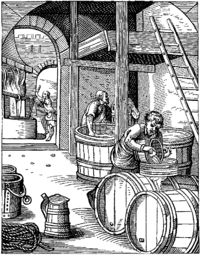
Photo from wikipedia
Pectinolytic yeasts can be applied to winemaking with the purpose of improving sensory and technological properties of wine because of their enzymes secreted during vinification. In this work, the autochthonous… Click to show full abstract
Pectinolytic yeasts can be applied to winemaking with the purpose of improving sensory and technological properties of wine because of their enzymes secreted during vinification. In this work, the autochthonous yeast-like pectinolytic strain from D.O. San Rafael viticulture region, Aureobasidium pullulans GM-R-22, was used in co-culture with Saccharomyces cerevisiae IOC 18-2007 in microvinification trials with Malbec must applying pre-fermentative cold maceration (PCM). A. pullulans remained viable during PCM and S. cerevisiae growth and fermentative kinetics were not affected in mixed culture with respect to pure S. cerevisiae culture. High pectinolytic activity (9.13 U/mg) was detected in mixed A. pullulans vinification during PCM, in which conditions of low temperature (8 °C), low pH (3.8) and high sugar concentration (250.6 g/L) governed. Mixed A. pullulans wine showed enhanced colour compared with pure S. cerevisiae wine, characterised by higher colour index and percentage of red colour, lower tonality and percentage of yellow colour, and negative values of b* and h* indicating more bluish and purplish tonalities. Moreover, filtration time and turbidity diminished by a 40% in mixed A. pullulans wine. The presence of GM-R-22 strain improved the production of desirable volatile compounds, such as esters and norisoprenoids, which displayed the maximum odour activity values (OAVs), whereas this strain reduced the total content of higher alcohols when compared to pure S. cerevisiae fermentation. Sensory analysis indicated that A. pullulans impacted on wine highlighting the violet hue, plum jam aroma, body and equilibrium that are distinctive features of Malbec variety. A. pullulans GM-R-22 seems to be promising for applying to low-temperature red winemaking as an adjunct culture to S. cerevisiae to improve the wine quality and vinification process.
Journal Title: International journal of food microbiology
Year Published: 2018
Link to full text (if available)
Share on Social Media: Sign Up to like & get
recommendations!